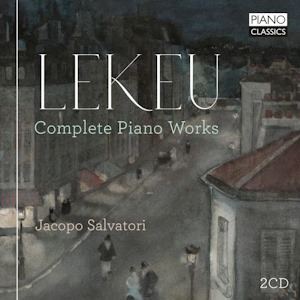
Guillaume Lekeu (1870-1894)
Complete Piano Works
Jacopo Salvatori (piano)
rec. 2019/22, Saletta “Eric James”, Vicenza, Italy
Piano Classics PCL10289 [2 CDs: 97]
Juan Arriaga, Lili Boulanger, William Baines: composers who did not reach the age of twenty-five, but managed in a short time to produce a sizable output of fine music. Guillaume Lekeu must also be placed in that unfortunate group. He was born in Belgium, moved with his family to Poitiers in the Vienne region of France when he was eight, and at eighteen went to Paris to study music. Between 1887 and 1892 he wrote several dozen works, especially chamber, piano and orchestral music.
Some of Lekeu’s piano music has been recorded before, but this is the first complete set. It includes works in manuscripts discovered by Jacopo Salvatori, who has truly dedicated himself to this project. The music is by turns melancholy, lyrical, populist, occasionally dark, and – despite Lekeu’s studies with Franck and d’Indy – always his own. These qualities are evident in the 1887 Pot-pourri, consisting of a Berceuse and a Vals. Both are treated in a kaleidoscopic manner that gives full play to the composer’s imagination.
Perhaps best-known of the composer’s piano works are the Morceaux égoïstes (1887-1888), of which at present we have all of Book 2, but only a single selection from Book 1. Jacopo Salvatori suggests that Lekeu may have written these pieces for his own use only. Yet they demonstrate all the sides of his personality, especially the Andante (No. 2) of Book 2, with its Alkanesque combination of sadness and brilliance, and the two Andantes (Nos. 4 and 5), in which very Romantic music appears in a Classical guise. The Lento doloroso from Book 1 lasts twelve minutes and is a powerful statement, orchestral in style and development, qualities almost equally demonstrated in the Andante religioso col più grand’espressione.
In 1891, Lekeu wrote what was later published as his Piano Sonata, although it is not certain that he intended it as a sonata or as a suite. Its five movements demonstrate a new fusion of the dramatic and the harmonically daring, and a little less of the melancholy of the earlier works. After a commanding Prélude, the composer presents not one but two fugal movements. They are so well-constructed that we are hardly aware that they are fugues at all, so attentive are we to their emotional aspects. The slow movement that follows is the most profound of the five; indeed, one is amazed at its depth of thought. Hardly less impressive is the Finale, which brings the work to a gentle, rather than powerful, end.
From 1892, Lekeu’s last compositional year, we have two works, the Three Pieces and a Berceuse. The first and third of the Three Pieces are reminiscent of what Lekeu might have heard in an outdoor café, but the central Valse oubliée, quite moving, shows new possibilities of expression that were never realized. The same can be said of the Berceuse; its original sense of harmony is combined with depth of feeling.
Jacopo Salvatori is known as composer and pianist. In the latter capacity, he has recorded a range of music from Debussy to Phillip Glass to Nino Rota. In both capacities, it was probably inevitable that he would come to the music of Lekeu. We have already mentioned his dedication. It is only equalled by his ability to highlight all aspects of the music, especially the polyphonic elements typical of any pupil of Franck’s. These discs, a must for fans of Lekeu, can serve as an excellent introduction to his music for those just discovering it.
William Kreindler
Help us financially by purchasing from



Contents
CD1
1) 3 Pieces, V.107
2) Berceuse, V.94
3) Piano Sonata in G Minor, V.105
4) Pot-pourri, V.95 (Intermède comique)
5) Andantino semplice e molto espressivo, V.93
6) Tempo di mazurka, V.106
CD2
1) Morceaux égoïstes, livre 2
2) Andante religioso col più grand’espressione, V.84
3) Morceaux égoïstes, livre 1
4) Moderato quasi largo, V.103
5) Pastorale (manuscript)
6) Fuga (manuscript)

















